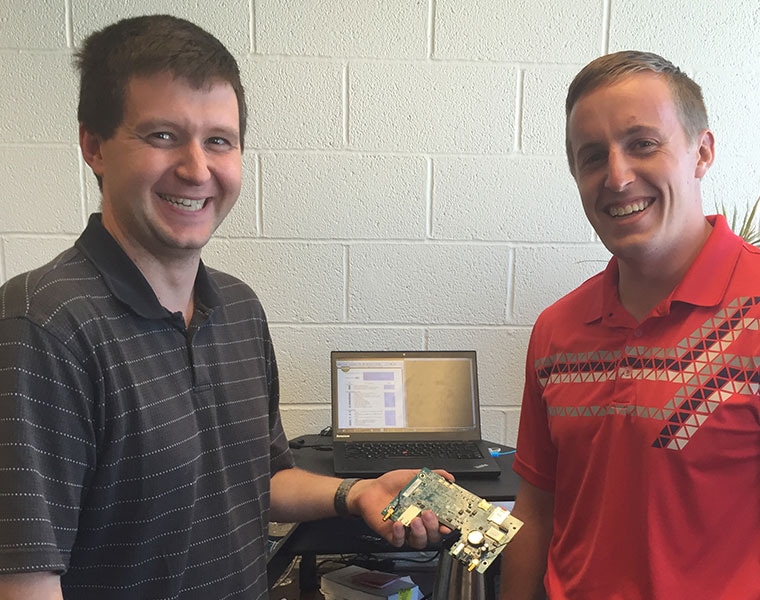Sep 22 2016
Intwine Connect LLC, a recent Case Western Reserve University “spin-in” venture from a startup based in suburban Chagrin Falls, is riding the vast connectivity needs driven by the so-called “Internet of Things” to rapid business expansion and job growth.
 Ryan May, chief engineer, (left) and Jim Basar, product manager, with a circuit board for an Intwine Connect device. Credit: Case Western Reserve University
Ryan May, chief engineer, (left) and Jim Basar, product manager, with a circuit board for an Intwine Connect device. Credit: Case Western Reserve University
Expanding business opportunities are also creating new real-world learning experiences for students at Case School of Engineering.
Intwine Connect leases lab space at Case Western Reserve to develop hardware, software, data analytics and other services enabling internet-connected “smart” devices needed for more efficient and productive businesses and buildings, including homes.
The Internet of Things (IoT) describes a network of devices with the ability to connect to the internet and one another, from personal fitness trackers to thermostats and power grids.
“We’re rapidly gaining traction in the IoT market by offering end-to-end network connectivity solutions that allow customers to reliably and securely collect critical performance data,” said Intwine Connect CEO and President Dave Martin. “We then provide analytics services enabling the conversion of this data into actionable information used by our customers to optimize business decisions.”
Martin, who earned an MBA from Case Western Reserve’s Weatherhead School of Management and founded Intwine in 2008, said six of the company’s nine employees are Case Western Reserve graduates or presently working toward an advanced degree.
The company’s formal link to the university, arranged through Case Western Reserve’s Technology Transfer Office (TTO) in 2014, proved to be the foundation for growth for the young company in the quickly expanding IoT market.
“I can’t say enough about the support I’ve received from the TTO,” Martin said. “Their creativity and flexibility over the last few years has been integral to Intwine’s success.”
“Some studies have estimated the IoT market at $1.7 trillion by the year 2020,” said Mike Allan, senior licensing manager with TTO. “It’s going to be everywhere and in everything—and that encompasses a lot of different areas and sectors.”
Recently, Intwine secured financing through the Innovation Ohio Loan Fund, which provides support to Ohio companies with limited access to capital due to risks associated with developing new products or services. The state’s $1 million loan will support hiring 25 employees—mostly software engineers—over three years as Intwine gains clients. Job responsibilities will depend on client needs.
Intwine Connect also is receiving ongoing financial support from CWRU Technology Ventures, the university’s venture capital fund focused on creating new businesses based on technologies developed at Case Western Reserve. On June 30, the fund’s review committee approved a phased-in investment of $217,500 in Intwine.
Intwine Connect’s business success is closely tied to its education mission, now linked with the university’s recently formed Institute for Smart, Secure and Connected Systems (ISSACS), which will lead initiatives in data science, cybersecurity, networks, embedded systems and other related IoT technologies. This partnership enables Intwine Connect to provide students real-world problems to solve while helping to foster the growth of key skills required by future engineers in the world of IoT.
Ken Loparo, the Nord Professor and chair of the Department of Electrical Engineering and Computer Science (EECS) at Case Western Reserve, has been involved with Intwine Connect since 2010 and serves as a key company advisor. Loparo and his team are involved in wide-ranging research that integrates streaming sensor data with custom analytics to enable informed decisions with applications to energy, health care and manufacturing.
“We are excited and committed to strengthening the relationship between Intwine and Case School of Engineering around the development and launch of the ISSACS project,” Intwine Connect’s Martin said. “Based on the creativity of EECS and TTO in collaborating with Intwine, we have the opportunity to create high-impact IoT engineering jobs in Northeast Ohio.”